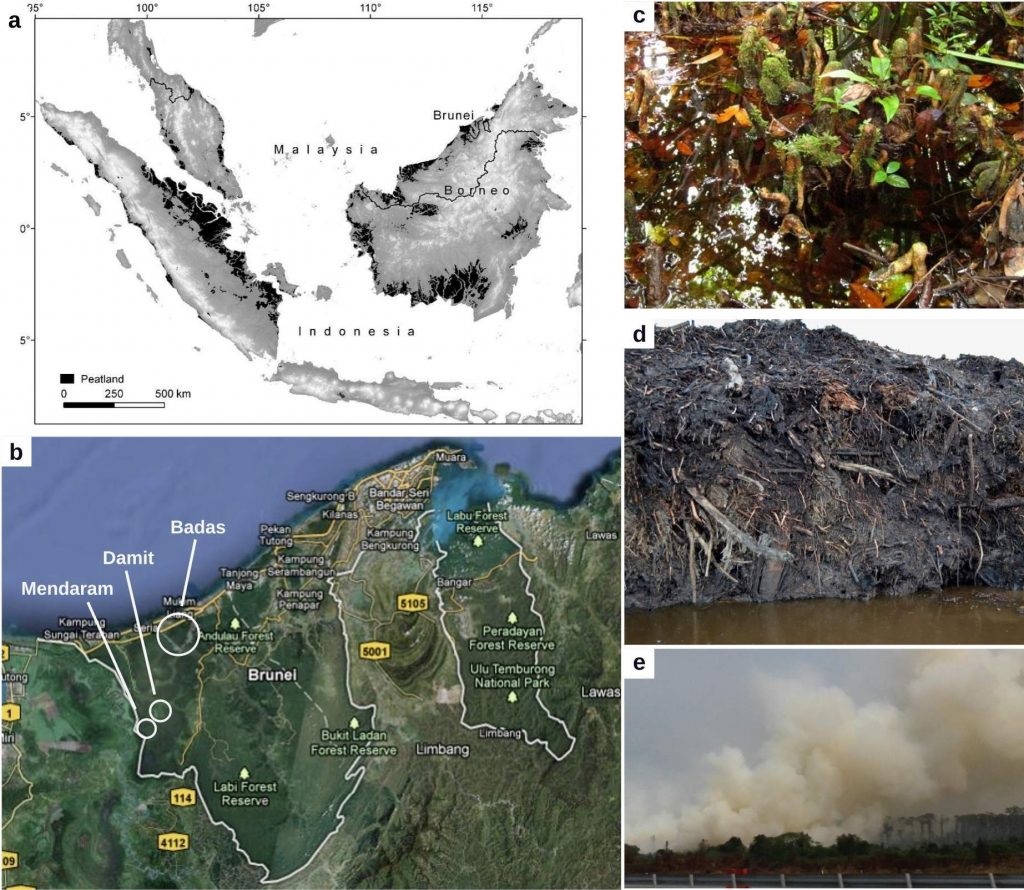
Tropical peat swamps are unique ecosystems that store gigatons of carbon dioxide as deposits of partly decomposed wood and other plant parts. Southeast Asian peatlands store over 10 times more carbon per area than does above-ground biomass in tropical Amazonia. These peat deposits have built up over thousands of years in wet, low-lying coastal areas of Brunei Darussalam and neighbouring countries because of waterlogging. However, once these swamps are drained for agriculture they become vulnerable to decomposition and fire. In the last thirty years, they have become endangered ecosystems and their degradation contributes significantly to human carbon dioxide emissions. Therefore, there is now great interest in protection and restoration of peat swamp ecosystems.
The ongoing collaborative projects between the Singapore-Massachusetts Institute of Technology (MIT) Alliance for Research and Technology (SMART) and Universiti Brunei Darussalam (UBD) aim to gain fundamental understanding of peat swamp ecosystems, in order to address practical issues related to their protection and restoration.
The five projects are:
- Carbon exchange and forest dynamics of tropical peat forests.
- Effects of nutrient cycling and light environment on peat swamp seedling growth and forest productivity.
- Hydrology, forest recovery and fire after Badas canal blocking.
- Reconstruction of historical demography in Bruneian tropical rainforests based on population genetic analysis of multiple forest tree species.
- Biodiversity and phylogeography of the peat swamp fish and insect fauna of Brunei Darussalam.
Together, these projects are contributing to the growth of Brunei Darussalam as a centre of peat swamp research.
These projects have establish and strengthen collaborations with numerous stakeholders including researchers from many international institutions (i.e. Nanyang Technological University (Singapore), Stanford University and MIT (USA), University of Potsdam (Germany), the Natural History Museum of Bern (Switzerland), University of Nairobi (Kenya), and Forest and Forest Products Research Institute, Kochi University and Ehime University (Japan), government agencies (Brunei Forestry Department and Heart of Borneo Brunei, Ministry of Primary Resources and Tourism) and non-government organisations (Wetlands International).
Such collaborative works have also focused on building local capacity amongst Bruneians for peat swamp research and tropical ecology research. As the main UBD collaborators, Dr Rahayu Sukri and Dr Faizah Hj Metali have greatly benefited through skills and knowledge transfer, award of external grant funding from SMART, increased networking with top ecology researchers and will be included as co-authors in publications from these collaborations. UBD MSc student Khalish Ideris was funded by SMART to undergo several research and training attachments at Nanyang Technological University in Singapore. Adi Ameza, also a UBD MSc student, was also funded by SMART for her laboratory analyses, field support and skills transfer. To date, seven UBD BSc students have participated in the collaborative projects as part of their undergraduate theses and more UBD BSc students are expected to start their new projects by the end of 2019. These projects have also supported two local part time research assistants. Staff from Brunei Heart of Borneo Centre and Brunei Forestry Department are also involved in fieldwork as part of skills transfer and capacity building.
Findings from the projects are primarily disseminated through scientific publications and are shared with the Brunei Heart of Borneo Centre and the Brunei Forestry Department which will be used to formulate management plans for Brunei’s peat swamp forests. These will contribute significantly to the conservation of Brunei’s peat swamp forests as important natural heritage for future generations.

Report & photos by:
Alex Cobb1,a, Suhailah Isnin1, Surin Kumar Thamilselvam1, Daniele Cicuzza2, Stefan Godeke2, Wardah Hj. Tuah2, Salwana Binti Md Jaafar2, Khalish Hafizhah Ideris2, Rahayu Sukri2,b, Faizah Hj. Metali2, and Charles Harvey1,3
1) Singapore-MIT Alliance for Research and Technology; 2) Universiti Brunei Darussalam; 3) Massachusetts Institute of Technology
Edited by: Dr Salwa Khalid

